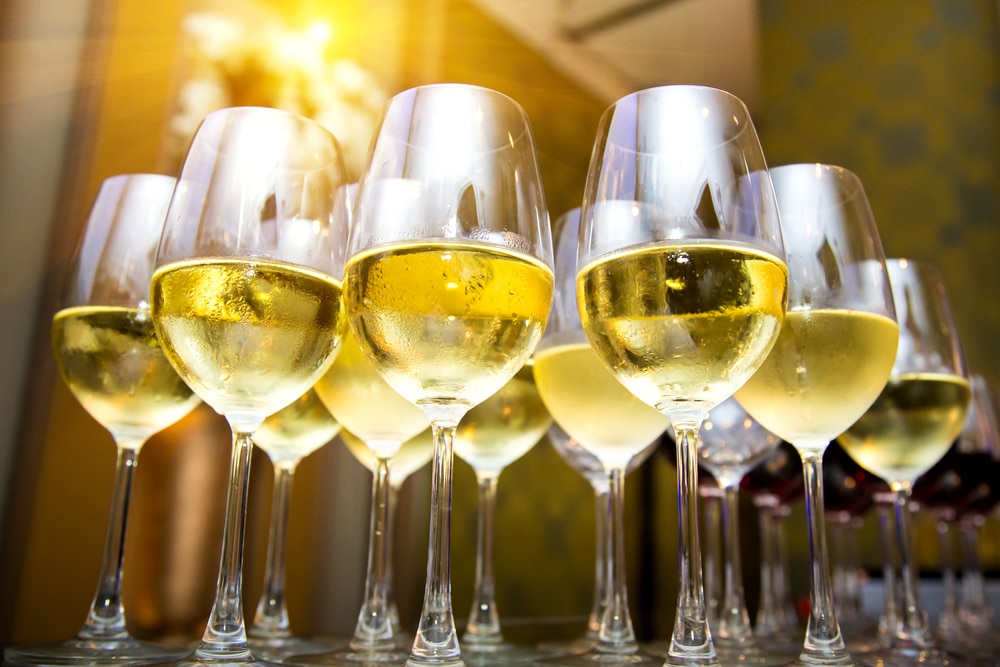Sparkling wine is a wine with significant levels of carbon dioxide in it, making it fizzy. While the phrase commonly refers to champagne, EU countries legally reserve that term for products exclusively produced in the Champagne region of France. Sparkling wine is usually either white or rosé, but there are examples of red sparkling wines such as the Italian Brachetto, Bonarda and Lambrusco, Spanish wine Cava, Australian sparkling Shiraz, and Azerbaijani “Pearl of Azerbaijan” made from Madrasa grapes. The sweetness of sparkling wine can range from very dry brut styles to sweeter doux varieties (French for ‘raw’ and ‘sweet’, respectively).[1]
The sparkling quality of these wines comes from its carbon dioxide content and may be the result of natural fermentation, either in a bottle, as with the traditional method, in a large tank designed to withstand the pressures involved (as in the Charmat process), or as a result of simple carbon dioxide injection in some cheaper sparkling wines.

In EU countries, the word “champagne” is reserved by law only for sparkling wine from the Champagne region of France. The French terms Mousseux and Crémant refer to sparkling wine not made in the Champagne region, such as Blanquette de Limoux produced in Southern France. Sparkling wines are produced around the world, and are often referred to by their local name or region, such as Espumante from Portugal, Cava from Catalonia, Prosecco, Franciacorta, Trento DOC, Oltrepò Pavese Metodo Classico and Asti from Italy (the generic Italian term for sparkling wine being spumante), and Cap Classique from South Africa. Sparkling wines have been produced in Central and Eastern Europe since the early 19th-century. “Champagne” was further popularised in the region, late in the century, when József Törley started production in Hungary using French methods, learned as an apprentice in Reims. Törley has since become one of the largest European producers of sparkling wine. The United States is a significant producer of sparkling wine today, with producers in numerous states. Recently, production of sparkling wine has re-started in the United Kingdom after a long hiatus.
Ancestral Method
Though it’s recently come back into fashion, the ancestral method of sparkling wine production is thought to predate the traditional method. Rather than induce secondary fermentation, the méthode ancestrale bottles the wine before it has completed its first fermentation.
The moment of bottling is crucial. There must be enough sugar in the wine to build pressure and create bubbles, but not so much that the bottle explodes. Because of this, many méthode ancestrale wines have softer bubbles, and there may be some residual sugar. There’s no requirement to disgorge the wine, so many méthode ancestrale wines contain sediment or appear cloudy.
While méthode ancestrale has been integrated into the legislation of regions like Bugey Cerdon for decades and practiced in Limoux for centuries, it has gained momentum via the pétillant-naturels of the natural wine movement.
“This method promotes natural winemaking techniques because you are bottling a fermenting wine, so most producers are not making any additions,” says Faith Armstrong Foster, who makes several California pét-nats as the winemaker and owner of Onward Wines and Farmstrong Wines. “No added yeast or sugar at bottling and no added dosage, sulfur dioxide or anything else [keeps] these wines pure, fresh and natural.”
While pét-nats gained traction in the Loire Valley, they’re now are produced around the world. Small-production wineries like them because much of the work must be done by hand.
Because there’s no regulated definition for pét-nats, some use the term interchangeably with méthode ancestrale wines. Others see pét-nat as a category of méthode ancestrale that’s focused on natural wine practices, like organic farming and indigenous yeast fermentation.
“I feel like many classic examples of ancestral wines do not subscribe to the pét-nat vibe,” says Caleb Ganzer, managing partner and wine director of Compagnie des Vins Surnaturels in New York. “It’s all about intention when it comes to how a wine is being categorized.”
